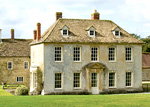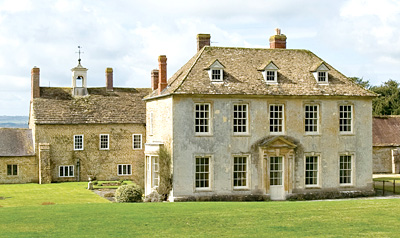A few careful owners: historic country houses for sale
Several historic country houses which have been carefully preserved by their owners, are on the market


As politicians prattle on about the ‘need for change', it's reassuring to see some English houses that have changed hardly at all in successive centuries. For sale for the first time in almost 60 years is magical, Grade I-listed Shanks House at Cucklington, near Wincanton, Somerset, an architectural gem with 70 acres of gardens, paddocks and ancient parkland overlooking the Blackmore Vale. Savills (01722 426880) quote a guide price of £5.5 million for this ‘exceptional' house, deemed ‘one of the best in the West' by selling agent Charlie Stone.
Shanks House dates from medieval times, and, in 1556, was owned by Lord Pembroke and rented by Robert Kemys, on whose death in 1587 the property passed to the Watts family. When the last of the Watts family died in 1729, the estate passed to a cousin, Nathaniel Dalton, and remained in that family until 1825, when Dalton's grandson, also Nathaniel, died. Dalton's only daughter had eloped with the dashing Capt Robert Foster Grant and his will stipulated that her husband must take the name Dalton if he wished to inherit the estate. Shanks remained in the Grant-Dalton family until 1920, when it was sold to its then tenant Sir Arthur Sutton. The present owners, the Morley family, bought the estate from his son, Sir Robert Sutton, in 1952.
The oldest parts of Shanks House date from medieval times, but the main north and east façades, built of creamy Cary stone under a stone slate roof, are typically 17th and 18th century in style, thought to have been refitted by Wincanton-based architect and garden designer Nathaniel Ireson (1685-1769), whose major works include nearby Stourhead. Internally, the house has some beautifully proportioned reception rooms, many of them, including the library, panelled in the mid-18th-century style, with high ceilings, grand fireplaces, oak floorboards, fine cornicing and original working shutters.
The main staircase has unusually fine plasterwork and carvings attributed by some to Grinling Gibbons. Shanks House has four main reception rooms, a kitchen/breakfast room, various domestic and family rooms, eight bedrooms and four bathrooms, with a courtyard of traditional buildings to the rear and, to the south, an 18th-century stable block, listed Grade II.

For sale through the same office of Savills, at a guide price of £2.25m, is exquisite, Grade II*-listed Mawarden Court, which stands in 15 acres of gardens, paddocks and woodland on the banks of the Avon at Stratford-sub-Castle, 2½ miles from Salisbury. The pretty stone manor house, which is in the lee of the Iron Age hill fort of Old Sarum, may have been named after Richard Mawarden, who was Knight of the Shire in 1403; it was later the home of Thomas Pitt, grandfather of William Pitt the Elder.
A Latin inscription, Parva sed apta Domino, dated 1673, which translates as ‘small but fit for a lord', aptly sums up this delightful house-part-Tudor, part-Queen Anne-which has three reception rooms, a kitchen/breakfast room, seven bedrooms and three bathrooms. Outbuildings include a one-bedroom bungalow, garages and stabling, plus an orangery with a swimming pool. The beautifully maintained gardens include 350 yards of single-bank fishing on the Avon.
The historic Manor House in the north Oxfordshire village of Duns Tew, 14 miles from Oxford, was one of three medieval manor houses on the Duns Tew estate left to his daughters by Hugh de Plessis in 1284. By 1719, all bar one part of the estate had been bought by the Dashwood family, but it was not until 1814, when Henry Dashwood acquired the remaining yardland, that the medieval Duns Tew estate was restored to its original standing.
Sign up for the Country Life Newsletter
Exquisite houses, the beauty of Nature, and how to get the most from your life, straight to your inbox.
From the early 18th century until late Victorian times, the Dashwoods' tenure of Duns Tew was marked by several periods of building and renovation, starting with the extension of the existing 17th-century manor house as a ‘hunting seat' in about 1710. The manor was remodelled in the mid 19th century, when a two-storey wing was added on the east side; a few years later, a large brick extension was added to the north. The estate remained in Dashwood family ownership until 1948, when it was sold off, with most of the land being bought by existing tenants.
The present owner, who inherited the house from her father, has brought up her own family there and is now downsizing, hence the sale of The Manor House with 46 acres of land, through Knight Frank (020-7629 8171) at a guide price of £5m. The classic, 13,587sq ft, William and Mary house has reception and inner halls, four main reception rooms, a kitchen/breakfast room, eight main bedrooms and four main bathrooms, plus additional bedrooms, bathrooms, a nursery and attics.
Outbuildings include a coach house with two staff flats, stables and garages. With no footpaths crossing manor lands, the gardens enjoy wonderfully private views over the Worton valley. But it wasn't only the landed gentry who had an eye for a good English country house, as can be seen from the history of Grade II*-listed Comarques at Thorpe-le-Soken, near Colchester, Essex.
Built in the 18th century by Joshua Lisle and later sold to a Capt Comarques, a Huguenot refugee from whom it takes its name, the house was extended in the 19th century when a two-storey wing was added, and again in the 20th century when a further single-storey extension was built on. Distinguished later residents include Henry Attlee, father of post war-Prime Minister Clement Attlee, and the author and journalist Arnold Bennett, who lived at Comarques from 1913 to 1921.
With its striking six-window range of early-19th-century sashes (similar to those at Braxted Park, Essex), the main south façade of Comarques is a model of architectural elegance that belies the extent of the living accommodation behind it. The house, which stands in some 48 acres of gardens, park and farmland, has entrance and reception halls, four reception rooms, a kitchen/breakfast room, a master suite, eight further bedrooms, three bath/shower rooms and a two-bedroom annexe. The grounds include a swimming pool, stabling and a former stable block with planning potential for conversion. Strutt & Parker (020-7629 7282) quote a guide price of £2.5m for Comarques as a whole, or it could be sold in two lots.
Country Life is unlike any other magazine: the only glossy weekly on the newsstand and the only magazine that has been guest-edited by HRH The King not once, but twice. It is a celebration of modern rural life and all its diverse joys and pleasures — that was first published in Queen Victoria's Diamond Jubilee year. Our eclectic mixture of witty and informative content — from the most up-to-date property news and commentary and a coveted glimpse inside some of the UK's best houses and gardens, to gardening, the arts and interior design, written by experts in their field — still cannot be found in print or online, anywhere else.
-
 What should 1.5 million new homes look like?
What should 1.5 million new homes look like?The King's recent visit to Nansledan with the Prime Minister gives us a clue as to Labour's plans, but what are the benefits of traditional architecture? And can they solve a housing crisis?
By Lucy Denton Published
-
 Having a ruff day: Kennel Club exhibition highlights the plight of vulnerable spaniel breeds
Having a ruff day: Kennel Club exhibition highlights the plight of vulnerable spaniel breedsPhotographer Melody Fisher has been travelling the UK taking photographs of ‘vulnerable’ spaniel breeds.
By Annunciata Elwes Published
